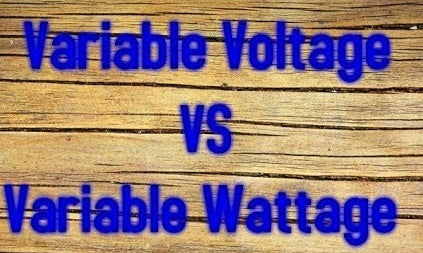Variable Voltage - Variable Wattage
What’s the difference between VV and VW? Which should I choose?
Right now, you either have a device with variable wattage (VW) and variable voltage (VV) settings, or you’re debating if you want to buy a device with one, or both, of these features. If you’re anything like me, you might have googled “VV and VW” and found a few articles, blog posts, and message boards explaining the differences between VV and VW settings in excruciating technical, scientific, and mathematical detail. Your eyes might have rolled back into your head once you reached the mathematical equation explaining the scientific wonders of Ohm’s Law, but seriously, who cares? You’re not trying to pass your high school science class, you just want to quit smoking cigarettes and start vaping already! Double settings, WHAT DOES IT MEAN?
Okay, just calm down, and take a few deep breaths. All that matters, is how to use VV or VW, and how these settings effect your vaping experience, and that’s all we’re going to talk about in this article. So here’s everything you need to know (in easy to understand terms) about VV and VW settings, and how to choose between the two.
VV and VW Basics and Similarities
In order to hone in your vape for the best flavor and vapor, you need to be able to adjust the heat. If you have VV and/or VW features, you can adjust for personal taste and for the ohms resistance of the header you’re using. To put it simply, less watts or volts will result in a cooler vape, while more volts and watts will result in a hotter vape. More=hotter, less=colder. Simple!
VV and VW Differences
Now that you know the basics, let’s talk about their differences. If you have a device with both settings, you’ll have to decide which setting to choose because you can’t set different volt settings AND different watts settings at the same time; the science doesn’t work that way. Sure, I could explainwhy, but that would require math, and that’s boring! So, just take my word on it; you can trust me. I suffered through the science, and the maths so you don’t have to. You can thank me by putting down those nasty cancer-sticks.
Variable Voltage works by you adjusting the volts either up, or down, in order to dial in on the perfect heat level. Since different headers have different resistances, you’ll also have to change the voltage setting if you change between different resistance headers. If you change to a header with higher ohms, you’ll need to up your volts. If you change to a header with lower ohms, then you’ll need to lower your volts to get the same experience.
Think of it like your driving a car. Your speed equals heat (or watts) and thegas pedal equals volts. If you want to maintain a steady speed across various types of terrain (the terrain represents the ohms resistance of your e cig header), you need to adjust the pressure on the gas pedal with your foot. You’ll push the gas pedal harder if there’s more resistance against the car (driving up an incline/more ohms), and ease up on the gas if there’s less resistance (driving down a hill/less ohms). That’s not a perfect example, but it’s the right frame of thinking. Now you almost know how to science! To put it simply: more ohms=more volts, less ohms=less volts. Easy!
Variable Wattage works a little bit differently than VV settings. If you choose to set your watts, instead of volts, the battery automatically adjusts the voltage to provide the wattage you selected, regardless of the resistance of your header. So if you decide to switch between different ohms resistance headers, you don’t need to change your wattage setting, because your e cig battery will do the math for you, how considerate!
You can think of VW settings like they’re cruise control settings. Instead of manually adjusting the gas pedal (volts) every time you encounter a hill, you set your cruise control to the speed (watts) you want once. Then, the car automatically calculates how much the gas pedal should be pressed for different inclines (more ohms), or declines (less ohms), in the terrain in order to maintain your desired speed.
So what’s better, VV or VW settings?
Well, that depends on you. There are benefits and draw backs to both, so let’s look at some of them.
How deep is your wallet?
VV devices are undoubtedly more wallet friendly than devices with VW options. If money is an issue, go ahead and start with a VV device. There are many budget friendly VV batteries out there, so you have a great selection to choose from.
Do you prefer ease of use or fine tuning?
VW settings are definitely easier to use. You can literally set it and forget it. You wont have to adjust the settings every-time you change your header. For this reason, I personally prefer to use my VW settings. But in all honesty, it’s not that hard to switch your VV settings. In-fact, there are some people who even prefer VV over VW because they can adjust the volts in smaller increments than watts – giving them a bit more control. But I’m lazy and can’t tell the difference, so I prefer using VW settings just because I can’t be bothered with clicking the button or spinning the VV dial; don’t judge me.
The Choice is Yours
Now that you know the differences, it’s up to you to decide. As long as you choose a device with one (or both) of these features, you can definitely feel confident that you’ll have an awesome time choosing between different flavors and headers. Just remember that VW works like cruise control, while VV is a more manual, yet fine-tuned, process. But with either setting, you will be able to harness the magic electrical power of science and finally put down those cancer-sticks for good! Vape on!



